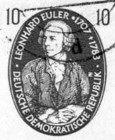Analytic Number Theory |
Index |

Russian Stamp, 1957 |

German Stamp 1957 |
From the time of Fermat (1601–1665) to that of Euler, the development of analysis was of primary interest. Consequently, there was very little progress in number theory during this period. Euler not only revived number theory, but applied analytic methods to his studies. Perhaps the result that brought Euler the most fame in his earlier years was his solution to what had become known as the Basel problem. This |
was to find a closed form for the sum of the infinite series of the form Many of the top mathematicians, including the Bernoulli family, had tried unsuccessfully to find this sum. However, in 1735, Euler succeeded where they had failed by verifying not only numerically, but exactly, the value of where the B2k are the Bernoulli numbers defined by |
After discovering this result on He considered the following infinite product over all primes p:  . .Using similar reasoning about infinite products for partitions, he asserted that a term of the above product will be of the form  where Known today as the Euler Product Formula, it is essentially an analytic way of stating unique factorization. |